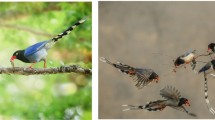Abstract
This study considers the optimal-trajectory generation problem in which a drone recognizes a wheelchair with an onboard camera while avoiding collision with obstacles. The optimal-trajectory generation was developed as a mixed-integer programming problem. The same method was used to recognize the wheelchair. In this regard, the optimal-trajectory generation problem was solved at each time step using model predictive control, and the first element of the optimal input was applied. The MATLAB optimization toolbox was used to solve this problem. As a result, the drone could avoid obstacles while recognizing the wheelchair that moved to the target trajectory considering the signals transmitted by the drone.







Similar content being viewed by others
References
Richards A, How JP (2002) Aircraft trajectory planning with collision avoidance using mixed integer linear programming. Proc Am Control Conf 3:1936–1941
Richards A, Schouwenaars T, How JP et al (2002) Spacecraft trajectory planning with avoidance constraints using mixed-integer linear programming. J Guid Control Dyn 25(4):755–764
Schouwenaars T, De Moor B, Feron E, How J (2001) Mixed integer programming for multi-vehicle path planning. In: 2001 European Control Conference (ECC), pp 2603–2608
Cekmez U, Ozsiginan M, Sahingoz OK (2016) Multi colony ant optimization for UAV path planning with obstacle avoidance. In: 2016 International Conference on Unmanned Aircraft Systems (ICUAS), pp 47–52
Thanh HLNN, Hong SK (2018) Completion of collision avoidance control algorithm for multicopters based on geometrical constraints. IEEE Access 6:27111–27126
Budiyanto A, Cahyadi A, Adji TB, Wahyunggoro O (2015) UAV obstacle avoidance using potential field under dynamic environment. In: 2015 International Conference on Control, Electronics, Renewable Energy and Communications (ICCEREC), pp 187–192
Chakravarty P, Kelchtermans K, Roussel T, Wellens S, Tuytelaars T, Van Eycken L (2017) CNN-based single image obstacle avoidance on a quadrotor. In: 2017 IEEE International Conference on Robotics and Automation (ICRA), pp 6369–6374
Gageik N, Benz P, Montenegro S (2015) Obstacle detection and collision avoidance for a uav with complementary low-cost sensors. IEEE Access 3:599–609
Velez P, Certad N, Ruiz E (2015) Trajectory generation and tracking using the AR. Drone 2.0 quadcopter UAV. In: SBR-LARS Robotics Symposium and Robocontrol, pp 73–78
Yamada I, Tanaka H, Matsumoto Y (2019) Development of drone guided landing system that combines AR marker and high-precision marker (in Japanese). In: Proceedings of the JSPE Semestrial Meeting, pp 431–432
Redmon J, Divvala S, Girshick R, Farhadi A (2016) You only look once: unified, real-time object detection. In: 2016 IEEE Conference on Computer Vision and Pattern Recognition (CVPR), pp 779–788
Ren S, He K, Girshick R, Sun J (2017) Faster R-CNN: towards real-time object detection with region proposal networks. IEEE Trans Pattern Anal Mach Intell 39(6):1137–1149
Taha HA (1987) Operations research, an introduction. Macmillan Publishing Company, New York
Mukai M, Murata J, Kawabe T et al (2008) Optimal path generation for automotive collision avoidance using mixed integer programming. SICE J Control Meas Syst Integr 1(3):222–226
Fotouhi A, Ding M, Hassan M (2017) Understanding autonomous drone maneuverability for Internet of Things applications. In: 2017 IEEE 18th International Symposium on a World of Wireless, Mobile and Multimedia Networks (WoWMoM), pp 1–6
Optimization Toolbox-matlab (2021). https://www.mathworks.com/products/optimization.html. Accessed 12 Oct 2021
Author information
Authors and Affiliations
Corresponding author
Additional information
Publisher's Note
Springer Nature remains neutral with regard to jurisdictional claims in published maps and institutional affiliations.
This work was presented in part at the 26th International Symposium on Artificial Life and Robotics (Online, January 21–23, 2021).
About this article
Cite this article
Watanabe, S., Mukai, M. Optimal trajectory generation of a drone for wheelchair tracking using mixed-integer programming. Artif Life Robotics 27, 159–164 (2022). https://doi.org/10.1007/s10015-021-00710-1
Received:
Accepted:
Published:
Issue Date:
DOI: https://doi.org/10.1007/s10015-021-00710-1




